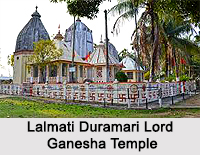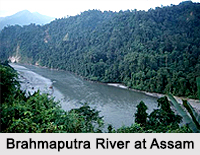 Tourism in Bongaigaon District entirely means a pleasant and enriching experience. This region offers a vast sightseeing options as well as adventurous options. There are several places of interest with deep historical relevance in this district. Apart from the historical options, the travellers also get to explore numerous natural views and beauties. Some of the beautiful tourism spots of Bongaigaon district of Assam include Bagheswari Temple, Kakaijana Proposed Wildlife Sanctuary, Lalmati-Duramari Ganesh Temple, Rock Cut Caves, etc.
Tourism in Bongaigaon District entirely means a pleasant and enriching experience. This region offers a vast sightseeing options as well as adventurous options. There are several places of interest with deep historical relevance in this district. Apart from the historical options, the travellers also get to explore numerous natural views and beauties. Some of the beautiful tourism spots of Bongaigaon district of Assam include Bagheswari Temple, Kakaijana Proposed Wildlife Sanctuary, Lalmati-Duramari Ganesh Temple, Rock Cut Caves, etc.
Bagheswari Temple is located on the top of in the middle of Bongaigaon town. It is proposed to be developed as afforested hillock with a garden and a small artificial lake fed by a perennial stream. The Bagheswari Hill houses ancient Lord Shiva temple inside a stone cave flanked either side by another two temples mainly temple of Bagheswari and Baba Tarak Nath. Every year a huge number of devotees pay a visit to Bagheswari hill top. In order to develop this beautiful site into a feasible eco-tourism and recreational spot, several developmental schemes were taken up and implemented in between 2001-2003.
Kakaijana Proposed Wildlife Sanctuary covers a huge area of the district. This declared Reserved Forest is approximately located 15 km away from Bongaigaon town in eastern direction. It has been proposed to be upgraded into a wildlife sanctuary. Golden Langur, which is found here, is rare in the world and is found only in this area of North Eastern region of the country. In addition to Golden Langur several other types of birds and different types of valuable shrubs and herbs are also found here. There is one hill spring called `Kalikapat` which flows through the forest and drains to the paddy field. There is also an ancient `Lord Shiva` temple on one of the hills. All these features of this wildlife sanctuary make it a popular tourist attraction among the people.
Further, the best specimens of the architecture of the Salasthambha period are the remains of the five rock-cut caves located at Jogighopa on the bank of the Brahmaputra River. These remains found in Bongaigaon District are considered as unique examples of rock-cut architecture in Assam. However, these rock-cut caves are not of huge architectural interest but these remnants at Jogighopa are the clear evidence of the fact that Assam was not outside the movement of this particular type of art developed in India as it will be seen from description of the best-preserved cave at Jogighopa. This Cave measures around 2.60 metre breadths, 1.8 metre in depth and 1.90 metre in height. It also has a roughly rounded ceiling. A platform of brick and mud masonry is found inside, which is a later addition. A chase running across the entire breath of the cave on the top serves to drain away rainwater from the front wall. The cave bears no sculptural designs. The other caves at the site have no flights, veranda, and are smaller comparatively. This architectural site has been taken up by the Archaeological survey of India for preservation.
Last but not the least, another beautiful historical attraction of this district is the Lalmati-Duramari Ganesh Temple. This temple is located near Abhayapuri town under North Salmara sub-division. It is one of the oldest temples of Assam. The historicity of the images is yet to be properly established. However, after a study of the stone carving and modes related to the carved idols, archaeologists opine that the temple and images belong to 8th to 10th centuries A.D. There are three views advanced as the reason for destructions of the Lalmati-Duramari Lord Ganesha Temple.  It says that earthquakes destroyed the temple and its images, while some others view is that Kalapahar who revolted against worshipers and priests destroyed the temple along with other temples and images in the North-East. The third view states that Burmese (People live in Myanmar) invaders who camped at Malegarh hills destroyed the temple along with the idols. However, it seems that earthquake has been the prime cause of the destruction of the temple.
It says that earthquakes destroyed the temple and its images, while some others view is that Kalapahar who revolted against worshipers and priests destroyed the temple along with other temples and images in the North-East. The third view states that Burmese (People live in Myanmar) invaders who camped at Malegarh hills destroyed the temple along with the idols. However, it seems that earthquake has been the prime cause of the destruction of the temple.
The existence of ruins in Lalmati-Durgamari area along with temples and images was brought to the notice of the Historical and Antiquarian Department of the Government of Assam in the year 1974. The department undertook excavation work that lead to the discovery of the temples, images and idols of the various Gods and Goddesses of this temple. The site of the temples is teemed with natural beauty and the state government is implementing every plan to upgrade the place to a major tourist attraction.



















